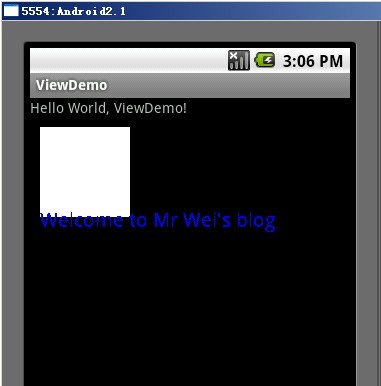最近在做软件从2.3到4.0的改变的一些工作,其中涉及了一些style和theme相关的东西。上网上查了一些东西,这个一并说说。关于android中style和theme的基本使用,这里就不再赘述了,可以查看Dev Guide上的东东,这里主要说说自己比较困惑的一些部分。
Android platform已经提供了许多的style和theme供开发者使用,可以在R.style类中找到可供使用的style,不过需要把其中的下划线(_)改成点号(.). 如果我们查看R.style类的文档,发现有些style没有描述或者描述的不怎么清楚,还是看看原文件中怎么定义的吧。style和themem的原文件可以在<ANDROID_SDK_HOME>/platforms/android-15/data/res/values/下面找到,其中styles.xml和theme.xml文件就是R.style类的定义文件。可以看到theme.xml中定义了Theme.Holo, Theme.Holo.Light等theme。
在values文件下还有一个文件就是attrs.xml,这是R.attr和R.styleable类的定义文件。attrs.xml中定义了每个view的可用的属性,例如使用android:textAppearance就是在attrs.xml中定义了<attr name="textAppearance" format="reference" />,那麽这里点format="reference"使什么意思呢?这里解释一下,一些例子来源于网络:
1. reference:参考某一资源ID。
(1)属性定义:
<declare-styleable name = "名称">
<attr name = "background" format = "reference" />
</declare-styleable>
(2)属性使用:
<ImageView
android:layout_width = "42dip"
android:layout_height = "42dip"
android:background = "@drawable/图片ID"
/>
2. color:颜色值
<declare-styleable name = "名称">
<attr name = "textColor" format = "color" />
</declare-styleable>
3. boolean:布尔值
<declare-styleable name = "名称">
<attr name = "focusable" format = "boolean" />
</declare-styleable>
4. dimension:尺寸值。
<declare-styleable name = "名称">
<attr name = "layout_width" format = "dimension" />
</declare-styleable>
5. float:浮点值。
6. integer:整型值。
7. string:字符串
8. fraction:百分数。
9. enum:枚举值
10. flag:位或运算
注意:
属性定义时可以指定多种类型值。
(1)属性定义:
<declare-styleable name = "名称">
<attr name = "background" format = "reference|color" />
</declare-styleable>
(2)属性使用:
<ImageView
android:layout_width = "42dip"
android:layout_height = "42dip"
android:background = "@drawable/图片ID|#00FF00"
/>
ok, 了解完这些,下面说说怎么自定义View和属性,可以参考http://blog.csdn.net/jincf2011/article/details/6344678
在xml 文件里定义控件的属性,我们已经习惯了android:attrs="" ,那么我们能不能定义自己的属性能,比如:test:attrs="" 呢?答案是肯定的.
进入主题。大致以下步骤:
一、 在res/values 文件下定义一个attrs.xml 文件.代码如下:
- <?xml version="1.0" encoding="utf-8"?>
- <resources>
- <declare-styleable name="MyView">
- <attr name="textColor" format="color" />
- <attr name="textSize" format="dimension" />
- </declare-styleable>
- </resources>
二、 我们在MyView.java 代码编写如下,其中下面的构造方法是重点,我们获取定义的属性R.sytleable.MyView_textColor, 获取方法中后面通常设定默认值(float textSize = a.getDimension(R.styleable.MyView_textSize, 36 ); ), 防止我们在xml 文件中没有定义.从而使用默认值!
MyView 就是定义在<declare-styleable name="MyView "></declare-styleable> 里的 名字,获取里面属性用 名字_ 属性 连接起来就可以.TypedArray 通常最后调用 .recycle() 方法,为了保持以后使用该属性一致性!
-
public MyView(Context context,AttributeSet attrs)
- {
- super(context,attrs);
- mPaint = new Paint();
-
- TypedArray a = context.obtainStyledAttributes(attrs,
- R.styleable.MyView);
-
- int textColor = a.getColor(R.styleable.MyView_textColor,
- 0XFFFFFFFF);
- float textSize = a.getDimension(R.styleable.MyView_textSize, 36);
-
- mPaint.setTextSize(textSize);
- mPaint.setColor(textColor);
-
- a.recycle();
- }
MyView.java MyView控件全部代码如下:
-
package com.android.tutor;
-
import android.content.Context;
-
import android.content.res.TypedArray;
-
import android.graphics.Canvas;
-
import android.graphics.Color;
-
import android.graphics.Paint;
-
import android.graphics.Rect;
-
import android.graphics.Paint.Style;
-
import android.util.AttributeSet;
-
import android.view.View;
-
public class MyView extends View {
- private Paint mPaint;
- private Context mContext;
- private static final String mString = "Welcome to Mr Wei's blog";
-
- public MyView(Context context) {
- super(context);
- mPaint = new Paint();
- }
- public MyView(Context context,AttributeSet attrs)
- {
- super(context,attrs);
- mPaint = new Paint();
-
- TypedArray a = context.obtainStyledAttributes(attrs,
- R.styleable.MyView);
-
- int textColor = a.getColor(R.styleable.MyView_textColor,
- 0XFFFFFFFF);
- float textSize = a.getDimension(R.styleable.MyView_textSize, 36);
-
- mPaint.setTextSize(textSize);
- mPaint.setColor(textColor);
-
- a.recycle();
- }
- @Override
- protected void onDraw(Canvas canvas) {
-
- super.onDraw(canvas);
-
- mPaint.setStyle(Style.FILL);
-
-
- canvas.drawRect(new Rect(10, 10, 100, 100), mPaint);
-
- mPaint.setColor(Color.BLUE);
-
- canvas.drawText(mString, 10, 110, mPaint);
- }
- }
三、将我们自定义的MyView 加入布局main.xml 文件中,并且使用自定义属性,自定义属性必须加上:
" xmlns:test ="http://schemas.android.com/apk/res/com.android.tutor" ,test是自定义属性的前缀, com.android.tutor 是我们包名.
main.xml 全部代码如下:
- <?xml
- version="1.0" encoding="utf-8"?>
- <LinearLayout
- xmlns:android="http://schemas.android.com/apk/res/android"
-
- xmlns:test="http://schemas.android.com/apk/res/com.android.tutor"
- android:orientation="vertical"
- android:layout_width="fill_parent"
- android:layout_height="fill_parent"
- >
- <TextView
- android:layout_width="fill_parent"
- android:layout_height="wrap_content"
- android:text="@string/hello"
- />
- <com.android.tutor.MyView
- android:layout_width="fill_parent"
- android:layout_height="fill_parent"
- test:textSize="20px"
- test:textColor="#fff"
- />
- </LinearLayout>
四、运行之效果如下图:

最后:
关于在引用资源时使用@还是?的问题,我们在设置style的时候既可以使用@也可以使用?, 例如android:textAppearance="@andorid:style/TextAppearance.Medium",
android:textAppearance="?android:attr/textAppearanceMedium"
使用@表示使用固定的style,而不会跟随Theme改变,这个style可以在style.xml中找到。
而?表示从Theme中查找引用的资源名,例如上面的textAppearanceMedium,查看themes.xml文件,可以看到在不同的theme中,textAppearanceMedium引用的style是不同的。如在Them.Holo中<item name="textAppearanceMedium">@android:style/TextAppearance.Holo.Medium</item>
,Theme.Holo.Light中为<item name="textAppearanceMedium">@android:style/TextAppearance.Holo.Light.Medium</item>
分享到:










相关推荐
Android 中的样式(style)和主题(theme)是两种资源,都是 Android 提供的默认资源,可以供开发者使用。同时,开发者也可以自己定义style和theme,以满足不同的需求。 style style是针对view的,例如TextView、...
在Android UI设计中,style和theme是两个至关重要的概念,它们极大地增强了应用界面的统一性和可维护性。这篇博文将深入探讨这两个主题,并通过具体的示例来解释它们的工作原理。 首先,我们来看`style`(样式)。...
在Android开发中,主题(Theme)和样式(Style)是构建用户界面的重要组成部分。它们允许开发者定义应用程序的整体外观和感觉,包括颜色、字体、布局等元素。动态切换Theme和Style可以提升用户体验,使得用户可以根据...
在Android开发中,为了提高UI设计的效率并保持界面的一致性,开发者通常会利用**Style**和**Theme**两个概念来实现统一的设计规范。本文将详细介绍这两个概念,并通过实例展示它们在实际项目中的运用。 #### 二、...
我们可以在这个Style中定义多个Item,每个Item都对应着一个属性,例如layout_width、layout_height、textColor等。 使用Style非常简单,我们只需要在XML布局文件中添加style属性,并将其设置为我们定义的Style名。 ...
@android:style/Theme.Translucent @android:style/Theme.Translucent.NoTitleBar @android:style/Theme.Translucent.NoTitleBar.Fullscreen 只需要在Manifest中需要透明的Activity内设置theme为以上任意一个就可以...
在Android应用开发中,主题(Theme)是控制应用程序全局外观和行为的重要元素。"Theme.Dialog"和"Theme.Holo.DialogWhenLarge"都是Android系统提供的两种不同的对话框主题。本篇文章将详细探讨这两种主题的区别,...
发现坑 最近在配置项目主题的时候报了如下错误: This Activity already has an...style name=AppTheme.NoActionBar> <item name=android:windowActionBar>false <item name=android:windowNoTitle>true <ite
在Android开发中,主题(Theme)是一个至关重要的概念,它为整个应用程序或应用程序中的特定组件提供了统一的视觉样式。主题可以定义颜色、字体、图标以及其他界面元素的外观,从而实现一致性和品牌识别度。本示例将...
可能会有一个<style name="AppTheme" parent="Theme.AppCompat.Light.DarkActionBar">,这表示"AppTheme"主题继承自"Theme.AppCompat.Light.DarkActionBar",这是一个常见的Android支持库提供的主题,包含轻量级背景...
在"android_studio_theme集合包"中,用户可能发现各种各样的主题,比如简洁的白色主题、深色的夜间主题,甚至是一些具有创意色彩的主题。下载并导入这些主题后,开发者可以根据自己的喜好和工作需求自由切换,以获得...
在Android开发中,为了实现界面的一致性和美观性,开发者通常会使用`Theme`和`Styles`来管理UI元素的样式和外观。本文将深入探讨Android中`Theme`和`Styles`的内部定义及其工作原理。 #### 二、Theme与Styles的基础...
在Android开发中,风格(Style)和主题(Theme)是两个重要的概念,它们允许开发者统一并自定义应用程序的外观和感觉。本篇文章将深入探讨如何在Android应用中动态地改变Style,以及Theme与Style的区别。 首先,让...
在Android开发中,主题(Theme)是应用全局样式和外观的重要组成部分。它们允许开发者通过一套统一的视觉风格来定制应用程序的界面元素,如颜色、字体、控件样式等,而无需在每个单独的Activity或布局文件中进行重复...
在"Activity_Theme_Style.rar_activity theme_android"这个压缩包中,包含的资源可能是一个关于如何自定义和应用Android Activity主题的教程。 首先,我们来了解一下Android中的主题系统。Android提供了预定义的...
在Android开发中,主题主要通过两种方式实现:style.xml文件和AndroidManifest.xml中的application标签。style.xml位于res/values目录下,是定义自定义风格和主题的主要场所。在这里,你可以定义一个或多个<style>...
首先,理解Android中的Theme(主题)是至关重要的。Theme是Android应用的全局样式,它定义了应用的整体外观和感觉,包括颜色、字体、布局等元素。我们可以创建自定义Theme,并在运行时动态切换,从而实现夜间模式...
在Android开发中,样式(style)和主题(theme)是用来统一和管理应用程序视觉表现的关键工具。它们允许开发者定义UI组件的外观和行为,并且能够轻松地在整个应用中应用和更改这些设定。 首先,我们来详细了解样式...
android:theme=”@android:style/Theme.Dialog” : Activity显示为对话框模式 android:theme=”@android:style/Theme.NoTitleBar” : 不显示应用程序标题栏 android:theme=”@android:style/Theme.NoTitleBar....
视频<activity android:name="com.android.ui.TypeActivity" android:screenOrientation="portrait" android:theme="@android:style/Theme.NoTitleBar" android:launchMode="singleTask"/> <activity android:name=...